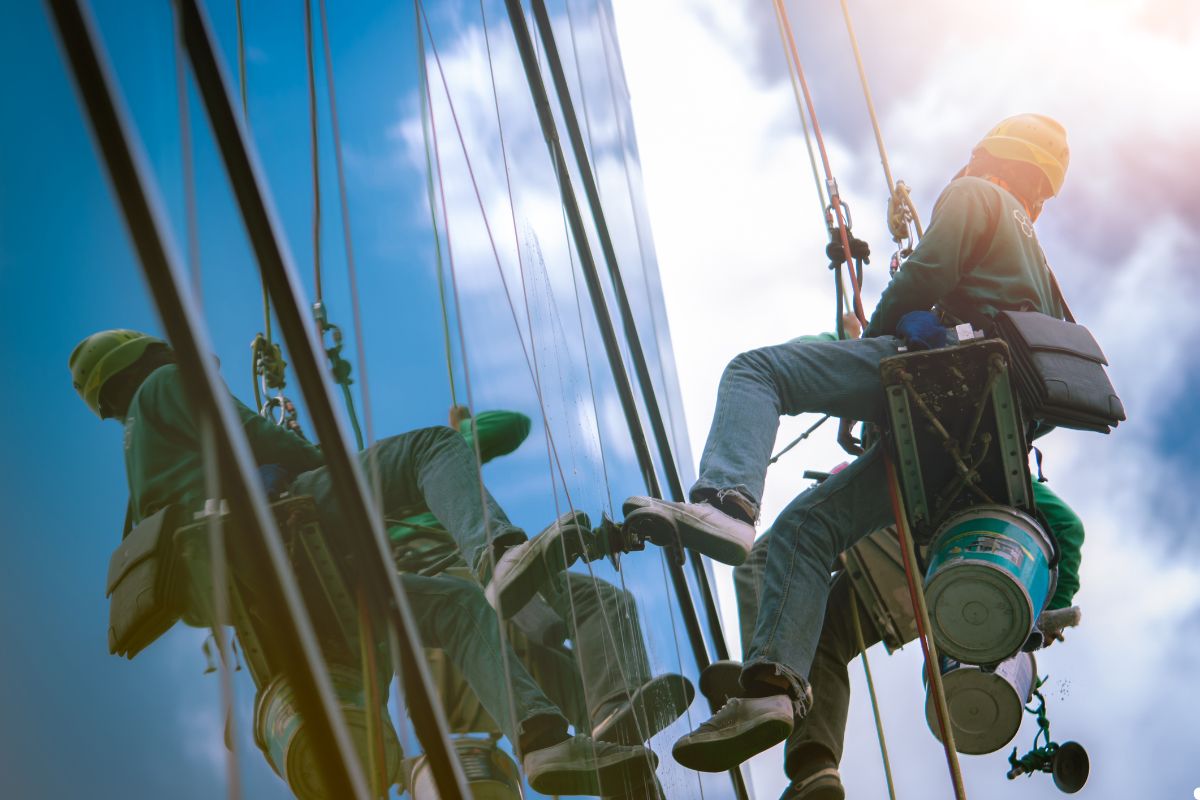
High-rise window cleaning requires specialized equipment to guarantee the safety of the workers and the quality of work. From personal protective equipment (PPE) and rope access systems to water-fed poles and robotic cleaners, window cleaners use a combination of gear to get windows sparkling clean on buildings. Let’s dive into the must-have window cleaning equipment to consider. Call us today to learn more about our services or to schedule a consultation!
Why High-Rise Window Cleaning Requires Specialized Equipment
Cleaning windows on tall buildings is unlike any other cleaning job. It involves extreme heights, varying weather conditions, and the complexities of different building designs. Without proper, well-maintained equipment, the risk of accidents and injuries significantly increases. Furthermore, improper equipment can lead to inefficient cleaning and unsatisfactory results. Regulations from organizations like OSHA add further emphasis to the need for specialized equipment. With all mirrored surface cleaning service, you get specialized care for every reflective surface, no matter the height or complexity of the building design.

Personal Protective Equipment (PPE) for Window Cleaners
Personal Protective Equipment (PPE) is the first line of defense for window cleaners working at heights. This includes a properly fitted safety harness, a sturdy helmet, gloves for grip and protection, and slip-resistant footwear. All PPE should meet or exceed industry standards and be regularly inspected. OSHA (Occupational Safety and Health Administration) sets specific standards for PPE in the workplace, and compliance is critical for the safety of window cleaning crews.
Rope Access Equipment
Rope access is a common technique in high-rise window cleaning, involving specialized equipment for suspension and controlled movement. This includes high-strength ropes, ascenders, descenders, and secure anchor points. Proper training and certification are essential for using rope access equipment safely and effectively. Routine inspections of the ropes and hardware are paramount to prevent equipment failure.
Fall Protection Systems
Beyond rope access, various fall protection systems provide an additional layer of safety. This could involve guardrails on platforms, safety nets, or permanent anchor points installed on buildings. The specific fall protection system required depends on the building’s design and the cleaning method used. Implementing a comprehensive fall protection plan is a must for any high-rise window cleaning operation.
Water-Fed Pole Systems
Water-fed pole systems have revolutionized high-rise window cleaning, allowing cleaners to reach great heights from the ground. These systems use telescoping poles to deliver purified water to the window surface, eliminating the need for ladders or platforms in many cases. Pure water dries spot-free, resulting in a pristine finish. The deionization and reverse osmosis ensures that the water is free from minerals and contaminants, which cause streaking.
Scaffolding and Platforms
While water-fed poles offer a ground-based solution, scaffolding and platforms remain essential for certain high-rise window cleaning tasks. Swing stages (suspended platforms) and boom lifts (aerial lifts) provide a stable work surface and allow cleaners to access hard-to-reach areas. Safety is the top priority when using scaffolding and platforms, requiring proper setup, inspection, and adherence to safety regulations.
Traditional Window Cleaning Tools
Despite advanced technology, traditional window cleaning tools still hold value. Squeegees, scrapers, and appropriate cleaning solutions play a role, particularly for interior cleaning and spot treatments. The key is to use high-quality tools designed for professional use.
Robotic Window Cleaning
Robotic window cleaning technology is an emerging solution for high-rise buildings. These robots use suction or magnetic adhesion to attach to the windows and are controlled remotely. While robotic cleaning is promising, it’s still an evolving technology with limitations in terms of adaptability and thoroughness.
Drone Window Cleaning
Drone technology is in its infancy stage in high-rise window cleaning technology. They require pilots and specialized cleaning solutions to carry. More technology needs to be done before putting on to market.
Regular Inspection Schedules
Regular inspection and maintenance are essential for all high-rise window cleaning equipment. Develop a detailed inspection schedule and train employees to identify potential problems. This proactive approach can prevent equipment failures, reduce accidents, and extend the life of your equipment.
Proper Storage and Handling
How you store and handle your equipment significantly impacts its lifespan. Store ropes in a cool, dry place away from sunlight and chemicals. Properly clean and maintain water-fed pole systems to prevent clogs and damage. Handling equipment with care minimizes wear and tear and ensures it’s ready for the next job.
OSHA Regulations for High-Rise Window Cleaning
OSHA regulations are the foundation of safety in high-rise window cleaning. These regulations cover fall protection, PPE, rope access, and other critical aspects of the job. Understanding and complying with OSHA regulations is not just a legal requirement; it’s a moral imperative to protect the safety of your workers.
ANSI Standards for Window Cleaning Equipment
ANSI (American National Standards Institute) develops voluntary consensus standards for various industries, including window cleaning. These standards provide guidelines for the design, performance, and use of window cleaning equipment. Adhering to ANSI standards demonstrates a commitment to safety and best practices.
Factors to Consider When Selecting Equipment
Choosing the right equipment requires careful consideration of several factors, including building height, window type, and budget. Invest in high-quality equipment from reputable suppliers, even if it means a higher upfront cost. The long-term benefits of increased safety, efficiency, and durability will outweigh the initial expense.
Reputable Equipment Suppliers
Purchasing equipment from reputable suppliers ensures that you’re getting quality products and reliable service. Look for suppliers with a proven track record, industry certifications, and a commitment to safety. Through our services, you gain access to suppliers with a proven track record and exceptional customer support.

Investing in Quality and Safety
In conclusion, investing in quality high-rise window cleaning equipment is essential for safety, efficiency, and the long-term success of your business. By prioritizing safety, following regulations, and choosing the right equipment for the job, you can ensure that your window cleaning operations are both effective and responsible. Ready to elevate your window cleaning operations with the right equipment? Contact us today to find the safest and most efficient solutions for your business.
FAQs
What are the most important pieces of safety equipment for high-rise window cleaning?
A safety harness, helmet, and slip-resistant footwear are paramount for protecting workers from falls.
How often should I inspect my rope access equipment?
Rope access equipment should be inspected before each use and regularly by a qualified inspector.
What are the advantages of using a water-fed pole system?
Water-fed pole systems allow cleaners to reach great heights from the ground, eliminating the need for ladders or platforms.
Where can I find reputable suppliers of window cleaning equipment?
Search online for companies specializing in window cleaning supplies or inquire with professional window cleaning associations.
What are the OSHA regulations for high-rise window cleaning?
OSHA regulations cover fall protection, PPE, rope access, and other critical aspects of the job. Consult the OSHA website or a safety professional for details. For personalized guidance or assistance, call us.


